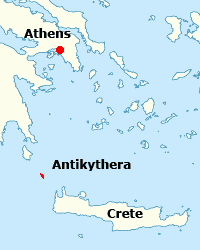Computing in the Time of Caesar

Usually we think of computers as shiny new devices. Recent discoveries, however, reveal that ancient Greeks may have had extremely sophisticated mechanical computers more than 2000 years ago.
This insight comes from a tarnished bronze device found by pearl divers in 1900 in the wreck of an ancient Roman freighter that sank near the Greek island of Antikythera. For years it sat ignored in an Athens museum — a metal curiosity in a world of marble statues — no one had any idea what it was. British physicist and science historian Derek Price spent years trying to figure it out, but submersion in seawater for two millennia had rendered its secrets indecipherable.

Modern imaging and computer modeling technologies now enable researchers to read inscriptions on the device and construct working models. It turns out the device was a mechanical computer that could calculate complex celestial cycles. Its discovery has radically altered our view of the kind of mechanical devices ancient cultures could build.
The clockwork-like mechanism contained more than 30 gears and several dials used for output. Analysis reveals that the gears calculated a 19-year cycle of lunar phases, dates of solar and lunar eclipses and positions of the planets. Greek builders would have had access to this astronomical information from highly precise Babylonian tables. Comparison with Babylonian eclipse records shows that the “programming” of the Antikythera device reflects cycles starting in 205 B.C.3

Research continues. The Greek government and Woods Hole Oceanographic Institution are conducting the first archeological examination of the site. Approximately 50,000 photographs taken by robot submarines have been processed to create a 3D map. This fall divers returned to the wreck using advanced diving suits that enable them to go deeper and stay down longer than before. They found an anchor, a huge bronze spear and objects suggesting there may be a second wreck. The team plans more extensive dives next Spring.4
The Antikythera device’s complexity and craftsmanship suggest that there must have been others. Where are they? In truth they probably were melted so their metal could be reused. That’s why museums are full of ancient marble statues, but few of bronze. Marble once carved can’t be used again, but bronze can.
And what’s the connection to Julius Caesar? Some think the sunken freighter was carrying looted treasures to Rome for a parade being planned for him.
If you want to learn more, there is a video on the web site of Nature magazine with scientist interviews, video showing how some of the analyses were done and demonstrations of working models.
Stay tuned.
-----
- Photo from Wikipedia.
- Map based on original created by Lencer, obtained from Wikimedia Commons.
- John Markoff, On the Trail of an Ancient Mystery, New York Times, November 24, 2014.
- Philip J. Hilts, Return to the Antikythera Shipwreck: The Exosuit’s First Mission, Scientific American, October 8, 2014 and Return to the Antikythera Shipwreck: Treasures Found (and Maybe a Second Ship), Scientific American, October 10, 2014.
- Edward O’Brien of the Woods Hole Oceanographic Institution testing the Exosuit. Photo from Scientific American article.
This article originally appeared in our free semi-monthly newsletter. To receive future issues, please add your name to the subscription list.

